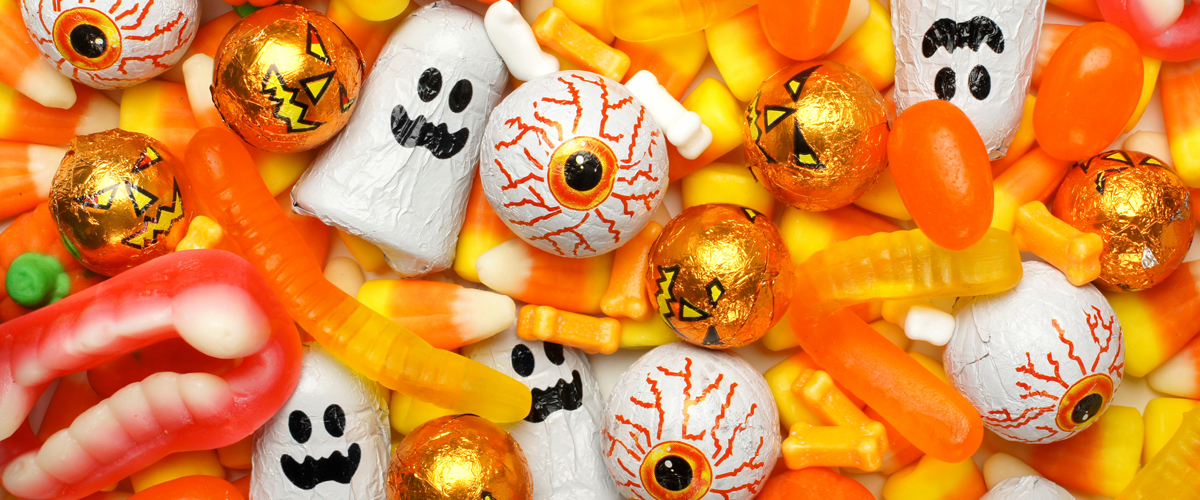What’s Really In Your Kids’ Candy?
Peeling back the wrapper on the ingredients in Halloween treats.

Sugar-laden sweets are a Halloween staple, but there’s much more to these treats than sugar. There are other ingredients in candy that may surprise you.
So what makes a fruit-flavored chew candy so brightly colored or keeps a chocolate-coated caramel candy bar smooth and creamy on the shelf until it’s purchased? The ingredient label holds the answer. (Keep in mind that fun-sized candy bars may even have different ingredients than their full-sized counterparts.) Scan the fine print and you’ll find oddly named additives or perplexing-sounding oils that might make you ponder.
“Many Halloween candies are full of synthetic dyes, partially hydrogenated oils, and other additives,” says Georgia Giannopoulos, a registered dietitian and manager of NYPBeHealthy, NewYork-Presbyterian’s health and well-being program. “Always read the ingredients and remember that some ingredients generally recognized as ‘safe’ by the U.S. Food and Drug Administration (FDA) are linked with health concerns if eaten at higher levels long-term.”
So what exactly are carmine, carnauba wax, and TBHQ, and why are these ingredients in so many of your kids’ favorite candies? Here is a list of common ingredients found in an assortment of popular packaged sweets and what you should know about them.
Ingredient: Corn Syrup/High Fructose Corn Syrup
Examples: chocolate candy bars; hard candies; chewy candies like candy corn
Description: Both are added sweeteners made from corn. Corn syrup is 100 percent glucose. High fructose corn syrup (HFCS) is processed to be nearly identical to table sugar and is often used in products that have to be extra sweet. Other than its sweetness, HFCS provides a soft, moist texture in chewy snack bars and other baked goods. It also helps prolong freshness.
Ingredient: Artificial Flavor
Examples: caramels and hard candies
Description: Companies use natural and artificial (synthetic) flavorings (sometimes both) to make their food taste better. That’s because certain flavors are difficult and expensive to replicate in processed foods. To achieve a familiar, mouthwatering taste of natural food, manufacturers combine chemicals to imitate a real taste. Natural flavors are from plants or animals while artificial flavors are synthesized in a lab. Typically, the individual chemical ingredients of the flavors aren’t listed.
Ingredient: Monoglycerides/Diglycerides
Examples: chocolate bars, taffy
Description: Monoglycerides and diglycerides are emulsifiers, which means they help oil and water to blend. These ingredients in candy are added to make them consistent in texture, creamier, and less sticky and to allow them to dissolve easily. These synthetic fats are often derived from vegetable oils (soybean, sunflower) or animal products (beef or pork).
Ingredient: TBHQ
Examples: peanut butter cups
Description: This synthetic antioxidant stands for tertiary butylhydroquinone. It helps extend the shelf life of candies by delaying oxidation and rancidity, helping food to maintain its nutritional value longer. The FDA regulates how much TBHQ can be added to foods because high doses of it can be dangerous.
Ingredient: Partially Hydrogenated oils
Examples: molasses and peanut butter candies
Description: Partially hydrogenated oils (PHOs) are those that have been turned from a liquid to a semisolid. Used to increase shelf life and give foods a desirable texture, this man-made trans fat has been proved to raise the bad kind of cholesterol levels in our body and lower the good kind, resulting in higher heart disease risk.
Ingredient: Red 40 or Yellow 5
Examples: chewy, fruity candies
Description: These dye colors are derived from petroleum and are used to give candies their bright colors. They contain benzidine, a human and animal carcinogen that, at low levels as permitted in dyes, is considered safe.
Ingredient: Carnauba Wax
Examples: chocolate-coated candies, cinnamon candies
Description: This natural, food-grade wax is derived from the leaves of the Carnauba palm and is used to coat or glaze candies for that attractive, shiny sheen. It’s also used in car wax.
Ingredient: Gelatin
Examples: gummies, marshmallow candies
Description: A thickening agent that is obtained from the protein collagen, which is made from boiling animal bones and skin like beef and pork in water. It’s also found in other foods such as yogurt, Jell-O, and ice cream, as well as some shampoos, face masks, and makeup.
Ingredient: Carmine
Examples: many red and pink candies
Description: This ancient red pigment/dye is a color additive. Derived from dried cochineal bugs, it’s used to create brightly hued candies. The FDA ruled that because the additive causes an allergic reaction in some consumers, it must be called out on food labels. Carmine is also found in some makeup items like lipstick and eye shadow.
Ingredient: Lecithin
Examples: coconut-chocolate candies, chocolate with hard candy shells
Description: This emulsifier is mostly obtained from soybeans, sunflower seeds, or eggs. It’s often used in chocolate to prevent ingredients from separating, reduces stickiness, and creates a smoother texture. Be mindful of this ingredient for children who have protein allergies.
Giannopoulos stresses that it’s important to understand not just the ingredients in candy, but in all foods marketed towards children. Trans fat, in particular, is “double trouble” for hearth health, she explains.
“Trans fat is found in frozen pizza, microwave popcorn, commercial baked goods like cookies, and other foods available year-round,” says Giannopoulos. “While safely enjoying some Halloween candies once per year is not concerning, regularly eating trans fat is.
“Remember to eat a nutritious meal or snack before trick-or-treating,” she continues, “and if your child has allergies, consider bringing along a special snack that you know is safe for them to eat while out and about. Wait until you’re home and inspect the candy in a well-lit spot to ensure that it’s safe to eat before you and your child dig in.”

